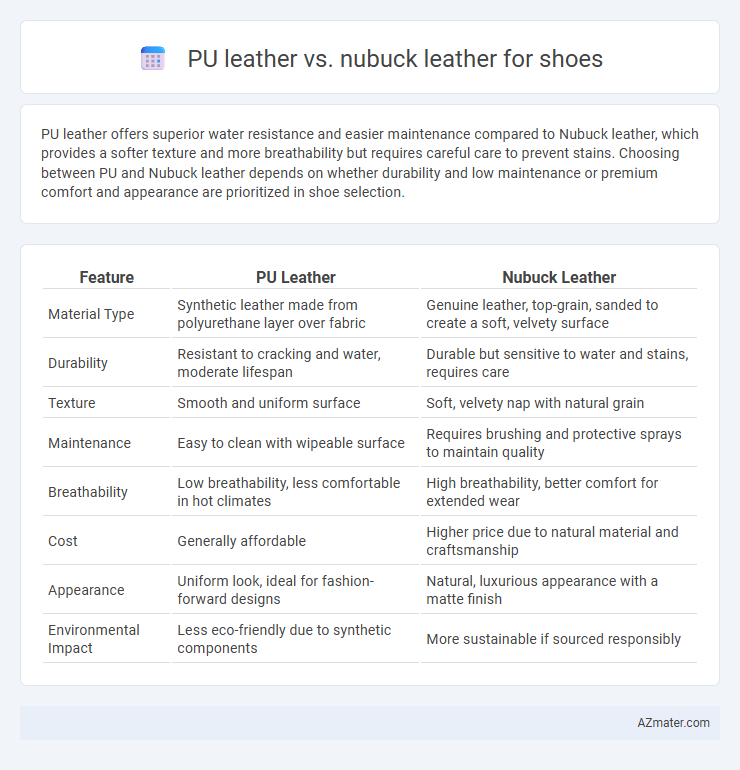PU leather offers superior water resistance and easier maintenance compared to Nubuck leather, which provides a softer texture and more breathability but requires careful care to prevent stains. Choosing between PU and Nubuck leather depends on whether durability and low maintenance or premium comfort and appearance are prioritized in shoe selection.
Table of Comparison
| Feature | PU Leather | Nubuck Leather |
|---|---|---|
| Material Type | Synthetic leather made from polyurethane layer over fabric | Genuine leather, top-grain, sanded to create a soft, velvety surface |
| Durability | Resistant to cracking and water, moderate lifespan | Durable but sensitive to water and stains, requires care |
| Texture | Smooth and uniform surface | Soft, velvety nap with natural grain |
| Maintenance | Easy to clean with wipeable surface | Requires brushing and protective sprays to maintain quality |
| Breathability | Low breathability, less comfortable in hot climates | High breathability, better comfort for extended wear |
| Cost | Generally affordable | Higher price due to natural material and craftsmanship |
| Appearance | Uniform look, ideal for fashion-forward designs | Natural, luxurious appearance with a matte finish |
| Environmental Impact | Less eco-friendly due to synthetic components | More sustainable if sourced responsibly |
Introduction to PU Leather and Nubuck Leather
PU leather, a synthetic material made by coating a fabric base with polyurethane, offers durability, water resistance, and affordability for shoe manufacturing. Nubuck leather is a top-grain cattle hide that has been sanded or buffed on the grain side to create a soft, velvet-like surface, prized for its breathability and luxurious texture in footwear. Both materials provide distinct aesthetic and functional qualities, influencing shoe longevity, maintenance, and style preferences.
Origin and Manufacturing Processes
PU leather, a synthetic material made by coating a fabric base with polyurethane, originates from chemical manufacturing processes designed to mimic genuine leather's appearance and texture. Nubuck leather is derived from top-grain cattle hide, carefully sanded and buffed on the grain side to create a soft, velvety surface, preserving natural markings and durability. The key manufacturing difference lies in PU leather's artificial production with polymer layers versus Nubuck's natural treatment and finishing of animal hide.
Visual and Textural Differences
PU leather exhibits a smooth, shiny surface with a consistent grain pattern, offering a polished and uniform appearance ideal for formal shoes. Nubuck leather showcases a soft, velvety texture created by sanding the outer surface, resulting in a matte finish with a natural, slightly rough feel that highlights rich color depth. The visual contrast between PU leather's sleek gloss and Nubuck's muted suede-like look emphasizes the tactile difference, with PU feeling firmer and Nubuck providing a plush, breathable touch.
Durability and Lifespan Comparison
PU leather offers higher water resistance and easier maintenance compared to nubuck leather, contributing to a longer lifespan under regular wear conditions. Nubuck leather, made from top-grain cowhide with a brushed surface, provides superior breathability but is more prone to scratches, scuffs, and moisture damage, which can reduce durability. For shoes subjected to frequent exposure and rough use, PU leather generally outperforms nubuck in terms of durability and longevity.
Comfort and Breathability Factors
PU leather offers a smooth surface with moderate breathability but tends to trap heat, making it less comfortable for prolonged wear. Nubuck leather, created from the outer side of the hide and finely sanded, provides superior breathability and a soft, velvety texture that enhances comfort. Shoes made from Nubuck generally allow better air circulation, reducing moisture buildup and foot fatigue compared to PU leather options.
Water and Stain Resistance
PU leather offers superior water and stain resistance compared to nubuck leather, making it ideal for shoes exposed to wet or dirty conditions. Nubuck leather, with its soft, suede-like texture, absorbs water and stains more easily due to its open pores and untreated surface. Protective sprays can enhance nubuck's durability but still fall short of the inherently resistant properties of PU leather.
Maintenance and Cleaning Requirements
PU leather shoes require simple maintenance involving regular wiping with a damp cloth and occasional application of leather conditioner to prevent cracking and maintain flexibility. Nubuck leather demands more careful care, including gentle brushing with a suede brush to remove dirt and avoid moisture exposure to prevent staining and texture damage. Both materials benefit from protective sprays, but Nubuck's porous surface makes it more susceptible to water and stains, necessitating more frequent and delicate cleaning routines.
Environmental Impact and Sustainability
PU leather, a synthetic material made from polyurethane, has a lower environmental impact compared to traditional leather due to reduced water usage and absence of animal farming but still relies on fossil fuels and produces non-biodegradable waste. Nubuck leather, derived from the outer layer of cattle hides, involves intensive water consumption, chemical tanning, and significant greenhouse gas emissions, raising sustainability concerns. Choosing PU leather over nubuck leather can reduce deforestation and animal welfare issues, though innovations in biodegradable and recycled PU materials are crucial for enhancing its eco-friendliness.
Price and Affordability
PU leather shoes generally offer a more affordable option compared to Nubuck leather, as PU leather is a synthetic material with lower production costs. Nubuck leather, made from the outer side of cowhide with a velvety texture, commands a higher price due to its natural quality and durability. Consumers seeking budget-friendly footwear often prefer PU leather, while those willing to invest in premium shoes may choose Nubuck for its aesthetic and longevity.
Which Leather Is Best for Shoes?
PU leather offers a cost-effective, water-resistant, and easy-to-clean option for shoes, making it highly durable for everyday use. Nubuck leather is prized for its soft texture, breathability, and premium appearance, but it requires more maintenance and is less resistant to moisture and stains. For long-lasting, practical footwear, PU leather is best, while nubuck suits those seeking luxury and comfort with careful upkeep.

Infographic: PU leather vs Nubuck leather for Shoe
 azmater.com
azmater.com